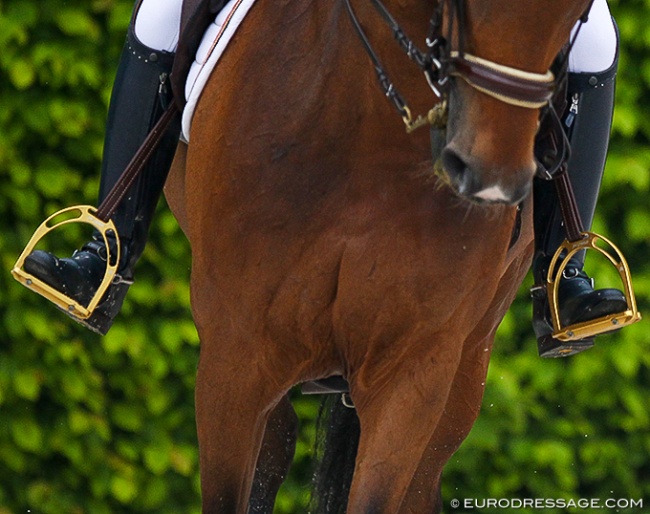
Shorter or longer stirrups? Well it depends.
It depends on your horse, your saddle, and which function you have in mind, whether you wish to sit more deeply, or perhaps sit lighter, in the direction of getting up to stand. Of course, this is all very dynamic and ever changing.
Finding the Ground
First let's look at some background. In the fourth century BC, Xenophon explained that a correct/classical dressage seat is “not that of a man seated on a chair, but rather the pose of a man standing upright with his legs apart,” so as to land on your feet and not your bum if the horse was removed.
As bipeds, humans are not created to find the ground through four feet or from sitting. Due to our evolution, we must find the ground through standing, and this reflex or desire is very strong. This works in our favour as jumping riders or even riding dressage with shorter stirrups and a light seat.
In the variation of longer stirrups and a deeper seat, we must unlearn the natural human instinct to try to find the ground. This is also why many riders grip with their thighs and push themselves out of the saddle. While riding, if we wish to sit deeply with longer stirrups, looking for stability in our legs may hinder an independent seat: tight hips, gripping thighs, bouncing, strong hands, fetal response, holding of breath, etc.
Stability will not come from our stirrups or the ground, but instead it must come from letting go and letting the movement of our horse carry us.
A Breathing Leg
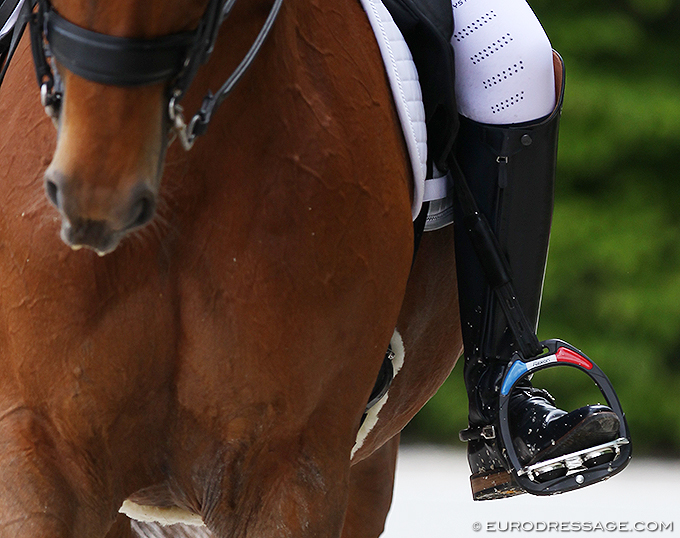
and stirrup length will determine whether your leg drapes softly
like a wet towel or not. Not everyone has long legs that
automatically fall into just the right place. Most important is
to be supple and elastic so you can comfortably follow your horse.
So to decide the correct stirrup length, don’t work against nature. The correct stirrup length should allow the horse between the legs to “breathe," expand and contract, bounce, etc. The seat should first following the natural movement of the horse, and then improve the gaits by influencing what is already there. Breathing and educated legs are needed to allow a horse to move correctly over its back, without blocking the horse.
We often see riders squeezing in the saddle and in fact blocking the horse, all be it unintentionally. It can lead to training issues like not pushing enough from behind, a dropped back, unsteady connection, ‘rein lameness", a flashy frontleg but a hindleg not coming under. This of course can all eventually lead to actual lameness.
Slightly longer stirrups
Slightly longer stirrups often feel unnatural to many riders, but keep in mind that a rider should achieve a feeling that he is melting into the horse.
At first, longer stirrups don't feel safe or reliable to the human design, but it can be learned! A rider needs to be supple in the saddle and not trying to stabilize himself. For the rider to sit in a supple position and in balance with the horse, the rider needs to be comfortable and let go of physical and mental tension. Without the rider finding their own comfort, extra effort and gripping occurs. Extra muscular effort and gripping will lead to a wobbly and unstable position in fact.
Or Shorter Stirrups?
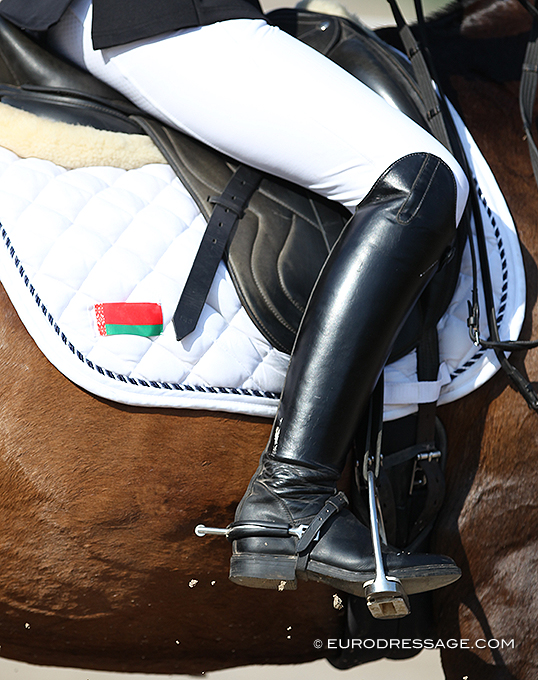
be helpful. An example of - it depends-
is seen here. This rider is drawing the knees up
in her short stirrups, causing her to inch backwards
to a chair seat. This combined with the foot
position and long spur is clearly undesirable
and not horse friendly. A more horse friendly
approach would use the shorter stirrups to
attain a deeper knee position, a slighter more
sympathetic seat an more caution and sensitivity
with the spur.
When there is an unstable feeling in the saddle, some riders automatically or deliberately attempt to stabilize by using even more muscular contraction or by jamming their heels down. This brings them further away from a supple seat, where every joint in the rider’s body must be relaxed.
Keep some flexibility in your mind around this subject. Xenophon suggested something akin to standing, but we are in fact sitting in the saddle. As with many things in riding that are not crystal clear, the rider is left to his own discovery and interpretation and the answer very often is indeed, "it depends." There usually is a middle place. Perhaps thinking of the riding position as a hybrid between standing and sitting will help you maintain a flexible mind set. The mindset of a life-long learner!
Riding with Uneven Stirrups
Many riders often ride with uneven stirrups, because they feel that even ones don't feel right. They either lengthen or shorten the straps a hole on one side and feel more in balance in the saddle, even though they actually sit crookedly.
To correct this, the rider first and foremost needs to make sure the saddle fit is ideal to take that out of the list of possible problems.
As beginners we are all taught to regularly switch our stirrup leathers to ensure even usage. Everyone has what’s called a standing leg, the leg they prefer to stack themselves over. This will eventually stretch the stirrups unevenly, even the ones marketed as non-stretch.
It is possible through Feldenkrais lessons to at least temporarily switch our habitual standing preference, but due to evolutionary design, humans require a single standing leg preference for quick reactions to get us out of harms way. So the idea of being totally even goes against our own design.
Don't by Fixated on Symmetry
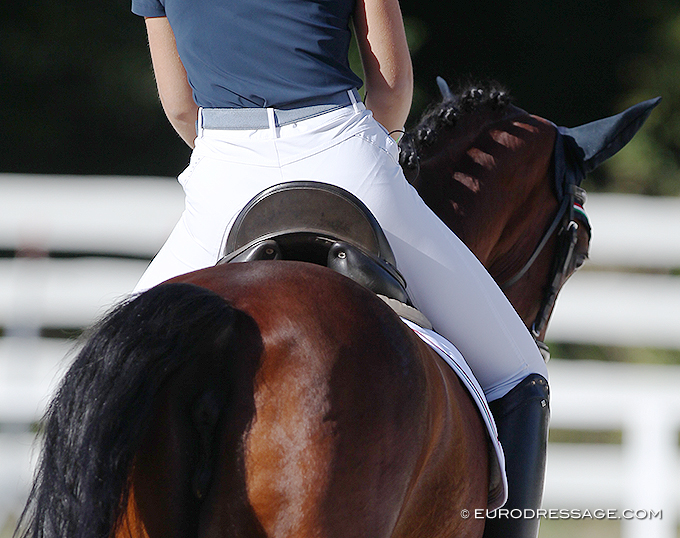
Leg length discrepancy is most often functional. Due to how we organize our skeletal and muscular systems, we get the impression that one leg is longer and one is shorter. Without a full medical diagnosis of an individual case, statistically speaking we can say that most differences are negligible, therefore the leg length discrepancy does not require outside assistance such as heal-lifts or uneven stirrups. However, studies have shown that there are indeed small anatomical differences in most people.
Habitual patterns can create the illusion of unevenness. Think of a marionette puppet with the puppeteer pulling he strings. In our case, the brain decides which strings to pull on, how to pull, in which direction, etc. Usually this bias is based on something that has served us well in the past. Therefore, the changes must occur there, not in the muscle or skeleton alone. Your nervous system’s intelligence has to see these updates as worthy for a reset.
One Hole Difference
According to Physiopedia, "a systemic review evaluating the prevalence of LLD by radiographic measurements revealed that 90% of the normal population had some type of variance in bony leg length, with 20% exhibiting a difference of >9 mm."
Many medical professionals will warn you, with good reason, to be very careful of adding heal lifts or in this case shortening one stirrup. My advice regarding heal lifts or uneven stirrups to help you possibly become more even is this: If you wish to experiment with it, do it as a lesson or discovery session to develop awareness and more feeling, staying clear of reliance on this configuration that may or may not make things worse over time.
Try not to self diagnose and be weary of an actual diagnosis or opinion as it may change your self-image in a negative way, seeing yourself as having a defect.
Retrain your Body to Avoid Crookedness in the Saddle
Crookedness, stiffness, struggle, pain or some other "defect"; we have them and our horses have them!
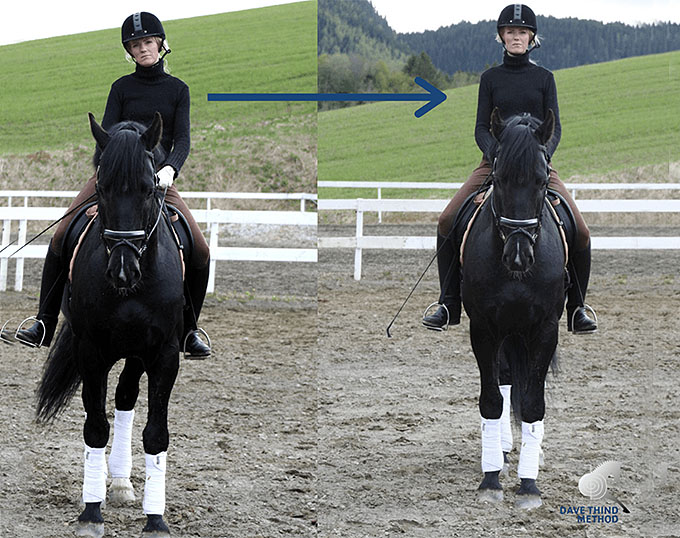
"This takes time to get used to and to learn through the brain and experience," she said. “Find a way to lead the movement and bypass the places that are stuck and so the pain disappears. Continuing in an effort to overcome your body's resistance will not only make the movement unpleasant, but also reduce the efficiency. The organism does not tend to accept and use that which is perceived as uncomfortable and unsupportive."
To learn more about this way of educating your nervous system in order to improve your riding and movement throughout daily life, visit www.davethindmethod.com. Live group classes, private sessions for individual cases and pre-recorded courses are available. To try a full free DTM class and discover other resources, fill out the form here and add Eurodressage.com as the subject.
by Dave Thind
Born in Canada and trained in Germany, Dave Thind has competed at the Grand Prix level in dressage and jumping. He is a noted equestrian biomechanics authority, with several published articles and appearances as an expert guest or lecturer to his credit. He received his German 'Trainer A' license in 2007. After a four year long education and certification, Dave is a Guild Certified Feldenkrais® Practitioner.
Related Links
New Dave Thind Method Class Series on 20 January 2021: Maximise Bone Health, Improve Stability and Strength for Riders
Christoph Hess: "The Most Important Part of Training a Horse is Training the Rider's Position"
Dave Thind: "Picture Yourself Being a Better Rider"
Improve Your Seat and Be Pain Free - Dave Thind Method: "Each Week Has The Potential For New Beginnings"